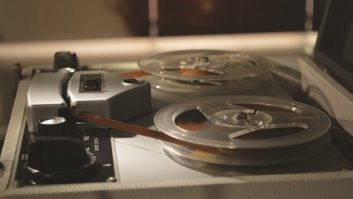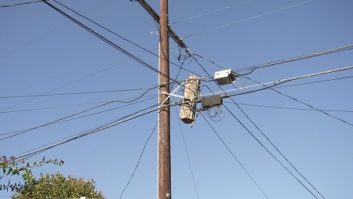New and nifty, or tried and true?
Sep 1, 2006 12:00 PM, By Chris Wygal
The time finally arrives when your GM asks you to have a seat in his office. He explains that the company is headed in a new direction and looking for change. Just when you think you’ve lost your job, he says, ��It’s time to rebuild the on-air and production facilities.�� So now, as you enjoy relief and certain job security, the equipment list, floor plans, time schedules and budget issues start racing through your head. And because you’re guaranteed to lose sleep for the next few weeks, you start thinking of some fresh new products you’d like to use and you ask yourself this question: ��What’s the one item in the facility that every on-air and production staff member will have an opinion about?�� Chances are, they’ll have something to say about the microphones.
There exists a breed of audiophiles who obsess over makes, models and manufacturers in their microphone arsenal. They miserably fiddle and fuss over placement, proximity and voice type when setting up mics for their sessions and on-air events. On the other hand, there is a rising number of audio engineers and production people who are less particular about microphones. They rely on good preamps, processors and postproduction techniques. This creates room for implementing less expensive microphones. Plus, the availability of inexpensive non-linear editing software has paved the way for new institutions such as podcasting and home recording studios. Thus, a massive crowd (with limited cash flow) is now in the market for inexpensive, yet effective microphones.
The rundown
AKG has recently introduced the Perception 100, 200 and 400 mics, which accommodate general purpose miking needs. The Perception 100 and 200 are much alike, offering a cardioid polar pattern and 1�� gold-sputtered diaphragm (a design feature that prevents shorting in high SPL situations). The Perception 200 adds a bass cut filter and 10dB switchable preattenuation pad, adding increased headroom for close miking. The 200 is also packaged with a metal carrying case and elastic spider shock mount, an added plus when compared to the 100’s metal stand mount. The dual-diaphragm deluxe Perception 400 takes the 100 and 200 design a notch higher in performance and price, offering features such as a polar pattern selector, which switches between cardioid, figure eight and omnidirectional pickup patterns. The Perception 400 is packaged with a metal carrying case and elastic spider shock mount and is better suited for more critical miking applications, especially when budgets are less limited. The 100, 200 and 400 models offer a rugged all-metal design and each weighs about 1lb. Optional accessories for the Perception series from AKG include a 48V battery supply and dc/dc converter, studio pop screen, external windscreen and floor stand.

New choices from long-established manufacturers offer high performance with an economical price, such as the AKG Perception 400.
The designs of the Audio-Technica 40 Series microphones seem the same at first glance, however each mic brings unique characteristics to the table. The A-T4033/CL, a tribute to the A-T4033, contains a vapor-deposited gold diaphragm that has been aged to ensure consistent performance and a nickel-plated brass acoustic element baffle that provides increased stability and sensitivity. The capsule and housing design are constructed to reject internal reflections, noise and vibration. The A-T4033/CL has a switchable 80Hz highpass filter to reduce unwanted low frequencies.
Designed much like the 4033/CL, the AT-4040 is a utility side-address condenser. The 4040 comes with a specially tensioned diaphragm. The 4040 has a switchable 80Hz highpass filter and 10dB pad.
The Audio Technica 30 Series offers the AT-3035 and AT-3060, two side-address condenser mics whose designs are more economical than the 40 Series, and still provide a great deal of quality for project studios and broadcast studios alike. The 3035 is designed much like the AT-4040, while the 3060 mimics the AT-4060 in its tube design. A real plus to the 3060 is the simple 48V phantom power supply requirement. Audio Technica also boasts the 20 Series that from a design perspective looks just like the 40 series. This includes the AT-2020, an affordable approach to general side-address miking needs, and the AT-2041, a package including an AT-2020 and AT-2021.
Audix has created the CX112 that fills the studio side-address condenser role in the extensive Audix microphone line-up. The single pattern cardioid contains a gold-sputtered diaphragm capsule that captures warm sonic characteristics, making it excellent for digital recordings. It lends itself strongly to instrument miking, as it can handle SPLs near 145dB. The mic comes equipped with a switchable 10dB pad, bass roll off, and can be switched on and off. The Audix SCX-25 is a unique condenser in its design and engineering. The large diaphragm capsule is mounted above a small, slender body that contains miniaturized circuitry, allowing the SCX-25 to leave a small, elegant footprint. The capsule is internally suspended, eliminating the need for an external shockmount.
Electro-Voice’s RE-20 offers a heavy steel design and hum-bucking coil reject EMI, and an integrated wind filter reduces and nearly prevents pops and sibilance. The RE-20 behaves much like a condenser in its frequency and transient response; however, the dynamic Acoustalloy diaphragm makes it effective in high SPL environments. Proximity effect and off-axis coloration are greatly reduced by Variable-D technology. Electro-Voice didn’t stop however with the RE-20. The RE-27ND is built just like the RE-20, except for its attractive satin nickel finish, and some changes in the diaphragm. The RE-27ND contains a neodymium alloy magnet and a reinforced diaphragm dome. This offers an increased output of nearly 6dB, and a noticeable response to high frequencies.
Other approaches
The Heil Proline is a series of dynamic cardioid studio microphones that not only meet or exceed sonic requirements, but are pleasing to those who appreciate classic radio aesthetics. The Heritage studio microphone mimics the Elvis microphone of the 1950s, with its chrome finish and birdcage design. Looks aren’t everything however, as the 1�� aluminum low mass voice coil construction and close attention to the phasing plug assembly produce a linear cardioid pattern, reducing proximity effect and responding nicely from 40Hz to 18kHz (a design common in the Proline series). A blue foam breath blast screen fits inside the shell, replacing the traditional silk screens used in older microphones.
The Heil Classic Pro Studio Microphone is a throwback to the familiar 1930s RCA broadcast mic. However, while the Classic Pro and Heritage models may look old, they are equipped with today’s technology. The Classic Pro is also a dynamic cardioid, and behaves sonically like the Heritage. Heil took the opportunity to have some fun with its retro Classic Pro and Heritage designs, but the Proline also offers microphone solutions that aesthetically compare to today’s microphone construction.

Function is important, but form can add some personality like the Heil Classic Pro.
The PR-20 and PR-30 are internally constructed much like the Classic Pro and Heritage Studio Microphones, using the same Proline element, low mass voice coil and sorbothane shock mount system. The PR-20 design matches that of a hand-held mic, while the PR-30 looks more like a standard shock-mounted studio microphone. Heil mixes things up with the the PR-40 by using a unique copper-wound voice coil, neodymium magnet structure and the Heil DM 6 dynamic element that creates frequency response as low as 28Hz. The PR-40 delivers the characteristics of an expensive condenser microphone, but without reproducing background noise, and eliminating the need for phantom power.
Sennheiser also has a stake in affordable studio microphones, touting the MD421II. The MD421II handles high SPLs and comes equipped with a five-position bass roll-off switch, making it flexible in correcting proximity effect.
Neumann has two mics tailored for broadcast use. The BCM 104 condenser mic offers an independent, functionally-optimized design derived from 3D simulations. The large-diaphragm condenser capsule features a cardioid directional pattern with internally switchable proximity effect compensation. A second switch allows the sensitivity to be reduced by 14dB.
Housed in a similar package, the BCM 705 is a departure from traditional Neumann designs because it uses a dynamic mic element. To enhance low frequencies, the entire chamber surrounding the capsule has been enlarged and acoustically coupled to a rear entrance port. The same wire mesh pop screen principles used in the KMS 105 and BCM 104 microphones are used in this mic, removing the need of foam in front of the capsule. The 104 and 705 have changeable, color-coded head grills for easier indentification.
Shure’s KSM line boasts the KSM 27,32 and 44 side address condensers. These mics contain Class A discrete transformerless amplifiers (for fast transient response and no crossover distortion), 1�� gold-layered low mass Mylar diaphragms, 15dB pads for high SPLs, three-stage pop protection grills, and internal shock mount design. The KSM 44 has added features such as externally biased dual diaphragm construction, and a three-position low frequency filter for greater proximity effect correction.
The 55SH Series II is reminiscent of the classic Shure Unidyne II birdcage design. The 55SH is great for use in unfavorable acoustic conditions, because the dynamic unidirectional cardioid pickup pattern minimizes sound from behind the mic. The 55SH is outfitted with an on/off switch and cartridge shock mount to reduce stand noise.
The Shure SM7B is a dynamic studio mic. The cardioid polar pattern provides minimum coloration of off-axis sound; a valuable feature for inexperienced voice and on-air talent. The SM7B comes with bass roll-off and middle frequency emphasis adjustments to help tailor sound, and an internal air suspension shock isolation system that reduces mechanical noise. The SM7B ships with the A7WS windscreen for added protection against plosive Ps, and allows for warmer vocal pickup.
Other quality, yet affordable studio microphones to look for include the JoeMeek JM Series, the Studio Projects B and C Series, the Rode NT1-A, NT2-A, NT3, NTK, NT1000 and 2000, the Rode K2 and the Rode Broadcaster. All these microphones are a part of the growing number of mic models that our favorite manufacturers are making available to fit the expanding need for cost-effective microphones. While the availability of condenser, tube and dynamic studio mics have become more widespread, their quality hasn’t fallen markedly, and if in fact newfound project studios are the driving force in making microphones more affordable, the radio industry can certainly take advantage.
Wygal is the programmer, engineer and Web designer for WRVL in Lynchburg, VA.
Resource Guide
Manufacturers of microphones
ADK
877-4 ADK MICS
www.adkmic.com
AKG Acoustics
615-620-3800
www.akgusa.com
Audio Engineering Associates
626-798-9128
www.wesdooley.com
Audio-Technica
330-686-2600
www.audio-technica.com
Audix
800-966-8261
www.audixusa.com
Avlex
877-447-9216
www.avlex.com
Behringer
877-672-0816
www.behringer.com
Beyerdynamic
800-293-4463
www.beyerdynamic.com
Blue Microphones
818-879-5200
www.bluemic.com
Brauner Microphones
702-365-5155
www.braunerusa.com
Cad Professional Microphone
800-762-9266
www.cadmics.com
Coles
207-773-2424
www.independentaudio.com
Countryman Associates
650-364-9988
www.countryman.com
DPA Microphones
303-823-8878
www.dpamicrophones.com
Earthworks
603-654-6427
www.earthworksaudio.com
Electro-Voice
800-392-3497
www.electrovoice.com
G Prime
212-765-3415
www.gprime.com
Hebden Sound
+44 114 201 3687
www.hebdensound.com
Heil Sound
618-257-3000
www.heilsound.com
Holophone
416-362-7790
www.holophone.com
Joemeek/PMI Audio
877-563-6335
www.joemeek.com
www.pmiaudio.comLawson
615-269-5542
www.lawsonmicrophones.com
Marshall Electronics
800-800-6608
www.mxlmics.com
Mojave Audio
818-847-0222
www.mojaveaudio.com
Nady Systems
621-644-4466
www.nadywireless.com
Neumann
860-434-5220
www.neumannusa.com
OKM Soundman
207-773-2424
www.independentaudio.com
Pearl Microphone Lab
+46 42 58 810
www.pearl.se
Rode Microphones
877-328-7465
www.rodemic.com
Roland Corp
800-542-2307
www.rolandus.com
Royer Labs
818-847-0121
www.royerlabs.com
Samson Technologies
516-364-2244
www.samsontech.com
Sanken Microphones
323-845-1155
www.promediaaudio.com/sanken
Schoeps/Posthorn Recordings
212-242-3737
www.posthorn.com
SE Electronics
408-873-8606
www.seelectronics.com
Sennheiser Electronic
860-434-9190
www.sennheiserusa.com
Shure
800-25-SHURE
www.shure.com
Sony Electronics
800-686-SONY
www.sony.com/proaudio
Sound Performance Lab
805-241-5140
www.spl-usa.com
Soundelux Microphones
323-603-3228
www.transaudiogroup.com/soundelux.shtml
Soundfield Research
+44 1924 201 089
www.soundfield.com
Studio Projects
310-323-9050
www.pmiaudio.com









